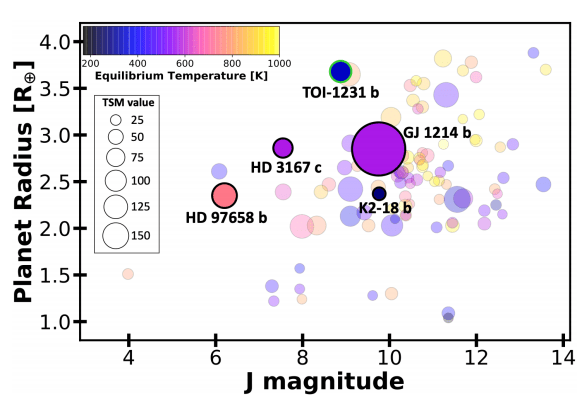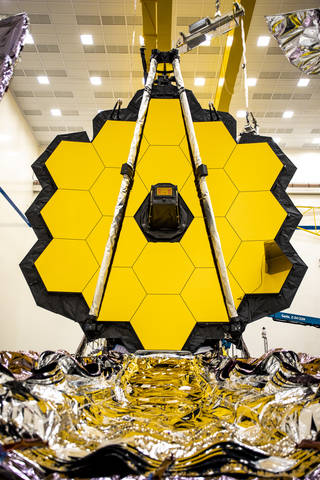TESS (Transiting Exoplanet Survey Satellite) has found a new planet, and the discovery of this sub-Neptune exoplanet has got scientists excited about atmospheres. The combination of the planet’s size, its thick atmosphere, and its orbit around a small M-class star close to Earth offers researchers the opportunity to learn more about the atmospheres of exoplanets. We are learning more about exoplanets, and studying their atmosphere is the next step to understanding them as a whole.
All our exoplanet detection strategies have an observation bias. It seems impossible to avoid. Even TESS (Transiting Exoplanet Survey Satellite), probably our best planet finder, has an observation bias. Its predecessor Kepler was oriented towards the larger planets, and TESS does not share this bias. But TESS still has a kind of blind spot because of how it works.
No telescope can look everywhere at once, and TESS is no exception. He observes the sky mainly in 28-day increments. So for one of these lumps, it focuses on one area for 28 days. To be confirmed as an exoplanet, an object must pass in front of its star twice during those 28 days. The end result of all of this is that most of the planets found by TESS have orbital periods of less than 14 days.
But this new planet, named TOI-1231 b, has an orbital period of 24 days. This makes it an excellent target for studying the atmospheres of exoplanets because it is longer in front of its star and can be more easily studied. Universe Today’s readers know that the study of light as it interacts with things is how we acquire most of our knowledge about space. TESS itself will not study the planet. Other missions like the James Webb Space Telescope (JWST) will take care of this by observing starlight as it passes through the planet’s atmosphere.
“This new planet that we have discovered is still strange – but it is one step closer to resembling our neighboring planets.”
Jennifer Burt, lead author of the article, NASA-JPL.
Since TOI-1231b spends so much time in front of its star compared to other TESS planets, missions like JWST will get a much better insight into it.
But it’s not just the planet’s orbital period that makes it an ideal target. Its size in relation to its star also helps. Since the star is so small, the planet blocks more of its light than if the planet and the star were more similar to the Earth and the Sun. “In a sense, this creates a larger shadow on the star’s surface, making the planets around the M dwarfs more easily detectable and easier to study,” the press release said.
The article describing the discovery of TOI 1321-b is titled “TOI-1231 b: A temperate planet the size of Neptune transiting through the neighboring M3 dwarf NLTT 24399. The lead author is Jennifer Burt, NASA JPL scientist. The article will be published in The Astrophysical Journal but is currently available on the arxiv.org pre-press site.
“By working with a group of excellent astronomers spread around the world, we were able to put together the data needed to characterize the host star and measure both the radius and the mass of the planet,†Burt said in a Press release. “These values ​​in turn allowed us to calculate the bulk density of the planet and to make assumptions about the composition of the planet. TOI-1231 b is quite similar in size and density to Neptune, so we believe it has an equally large gas atmosphere. “

The new planet has a radius of approximately 3.65 times that of Earth. It has an orbital period of 24.26 days and a mass of about 15.5 earth masses. The star it orbits is a dwarf M star located about 90 light years from the constellation Vela.
The planet is much closer to its star than the Earth is to the Sun. But 1321b is roughly the same temperature because its star is so much cooler than the Sun. This lower temperature also makes it a desirable object for further study with the JWST and other telescopes. Its equilibrium temperature is only around 330 Kelvin, making it one of the coldest small planets available for atmospheric study. For comparison, Earth’s average temperature is around 288 Kelvin, and an ultra-hot Jupiter can have a daytime temperature of up to 2700 K, hotter than many stars.
“TOI-1231b is one of the only other planets we know of in a similar size and temperature range, so future observations of this new planet will allow us to determine how common (or rare) it is for Clouds of water are forming around temperate worlds, â€said Burt.

In addition to his desirability as a target, he has high systemic radial velocity. Astronomers are particularly enthusiastic about this because it can allow the observation of low velocity hydrogen atoms escaping from the atmosphere. The characteristics and relationship of TOI-1231 b with its star are similar to those of another star named GJ-436 and its planet GJ-436 b. GJ-436 b is well known for its atmospheric escape, so astronomers believe that the newly discovered exoplanet will also experience atmospheric escape, albeit at a much lower rate than GJ-436 b. Hydrogen is the most likely culprit for the breakout, but it’s hard to see due to the presence of interstellar gas. But TOI-1232 b is moving away from Earth very quickly, making the hydrogen more visible.
Diana Dragomir is one of the co-authors of the article. In the same press release, she said: “The low density of TOI-1231b indicates that it is surrounded by a substantial atmosphere rather than being a rocky planet. But the composition and extent of this atmosphere is unknown! said Dragomir. “TOI-1231 b could have a large atmosphere of hydrogen or hydrogen-helium, or a denser water vapor atmosphere. Each of these would indicate a different origin, allowing astronomers to understand if and how planets form differently around M dwarfs compared to planets around our Sun, for example. Our next HST observations will begin to answer these questions, and JWST promises an even closer examination of the planet’s atmosphere.
It will be some time before JWST can train its sensors on the newly discovered exoplanet, even though the space telescope will be launched soon (â„¢). But the Hubble is ready to go. In fact, one of the article’s many authors plans to observe TOI-1231b later this month.

All these discoveries of exoplanets show us the great variety present in other solar systems. There are some downright strange planets, at least compared to Earth. But this one is more Earth-like than any of the hot Jupiters we’ve found, and while it’s still different, it could at least teach us something about our own solar system and the planets that reside there.
“One of the most intriguing findings from the past two decades of exoplanet science is that, so far, none of the new planetary systems we’ve discovered resemble our own solar system, â€Burt said. “They’re full of planets between the size of Earth and Neptune in orbits much shorter than Mercury, so we don’t have any local examples to compare them with. This new planet we’ve discovered is still strange. – but that’s one step closer to resembling our neighboring planets a bit. Compared to most of the transit planets detected so far, which often have scorching temperatures of several hundred or thousand degrees, TOI-1231 b is positively icy.
 Universo Viviente
Universo Viviente



